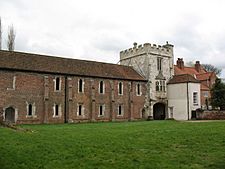Cawood Castle facts for kids
Quick facts for kids Cawood Castle |
|
|---|---|
| North Yorkshire, England | |

Banqueting hall and gatehouse at Cawood Castle
|
|
| Coordinates | 53°49′53″N 1°07′51″W / 53.8315°N 1.1309°W |
| Type | Quadrangular castle |
| Site information | |
| Owner | Landmark Trust |
| Open to the public |
For holiday let |
| Site history | |
| Materials | Stone and brick |
|
Listed Building – Grade I
|
|
| Designated | 5 December 1928 |
| Reference no. | 1011518 |
Cawood Castle is a very old and important building in the village of Cawood, in North Yorkshire, England. The parts of the castle you can see today were built in the 1400s. It was once a strong, fortified home for the Archbishops of York, who were important church leaders. Much of the castle was taken apart after the English Civil War.
Contents
History of Cawood Castle
Early Days of Cawood Castle
It is thought that King Athelstan built the very first fort at Cawood. This was on the same spot where the castle ruins are now. By the 1100s, Cawood had become a home for the Archbishops of York. The castle was first mentioned in records in 1181. Between 1374 and 1388, it was changed into a quadrangular castle. This means it had a rectangular shape with buildings around a central courtyard.
Many kings visited Cawood Castle. One was King John, who came to hunt in the nearby Bishop's Wood in the 1200s. Records show that the palace was often made better over time. For example, Archbishop John Kemp built the impressive gatehouse. He used stone from Huddlestone quarry, which also supplied stone for York Minster.
The Great Feast of Cawood
In 1465, George Neville became the Archbishop of York. He held a huge feast at Cawood Castle. His brother, the Earl of Warwick, helped plan the event. People said he wanted the feast to be even bigger than the King's own coronation party!
Important guests attended, including the Duke of Gloucester, who was the brother of King Edward IV. The feast lasted for several days. It became known as the "Great Feast of Cawood" because of how enormous it was. Records from the feast show that a massive amount of food was eaten. This included 104 oxen, 6 wild bulls, 400 swans, 1000 capons (a type of chicken), and 104 peacocks. Guests also drank 25,000 gallons of wine!
Famous Archbishops at Cawood
Cawood Castle was the main home for Thomas Savage when he was Archbishop of York. He passed away at the castle in September 1507.
Later, Cardinal Wolsey came to Cawood in 1530 as the Archbishop of York. He quickly became popular with the local villagers. He worked to fix things that had been neglected for many years. However, before he could officially become archbishop in York, he was arrested. This happened on charges of serious disloyalty. Wolsey became very ill on his journey to London and died. His death meant he fulfilled an old prediction. It was said he would see the towers of York Minster but never be officially installed there.
The English Civil War and Destruction
In 1642, the English Civil War began in England. At first, the castle was held by the Royalists, who supported the King. However, the Parliamentarians, who supported Parliament, soon captured it. For a short time in 1644, the Earl of Newcastle took it back for the Royalists.
But soon after, Lord Fairfax recaptured the castle. It was then used as a camp for prisoners of war. After the war ended, the castle was left empty and destroyed. Only the farm buildings and parts of the wall were left standing. The castle's cellar was filled in with rubble and soil.
Cawood Castle Today
What Remains of the Castle
Today, the only main parts of Cawood Castle that are still standing are the gatehouse and the banqueting hall. Stones from the destroyed castle were used to build houses nearby. You can also still see the foundations of some other old structures. The castle's cellar was dug out again in the 1800s.
The gatehouse was used as a courthouse until the 1930s. During World War II, it served as a place for officers and for the Home Guard.
Current Use and Restoration
The castle is now owned by the Landmark Trust. This group restores historic buildings. They have turned the gatehouse into a holiday home where people can stay. The two-storey banqueting hall has been made safe and protected from the weather. However, it is not set up for people to live in.
Outside the banqueting hall, you can see where other buildings used to be. There were once more modern farm buildings and a wall along the road. These were removed when the Landmark Trust took over the castle and restored it.
The Castle Garth
The open grassy area near the castle, called the castle garth, was bought by the local parish council in the 1980s. They wanted to keep it as an open space for everyone in the village to enjoy.
The garth is home to a group of great crested newts. In the middle of the garth is a pond. This pond was built in the 1800s for ice skating. You can also still see the remains of medieval fish-ponds. The area has been improved with money from a special fund that helps communities bring their local heritage to life.


